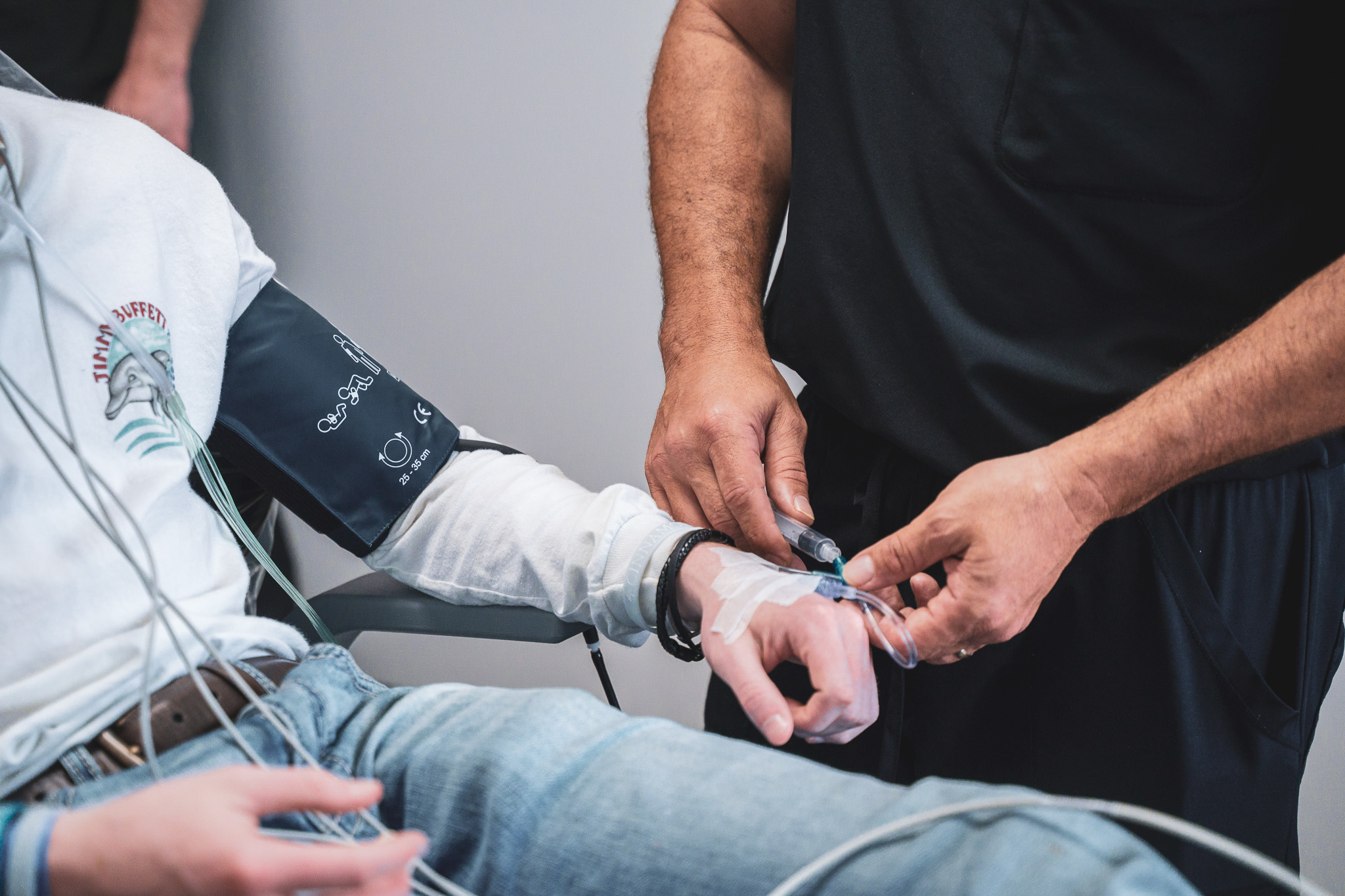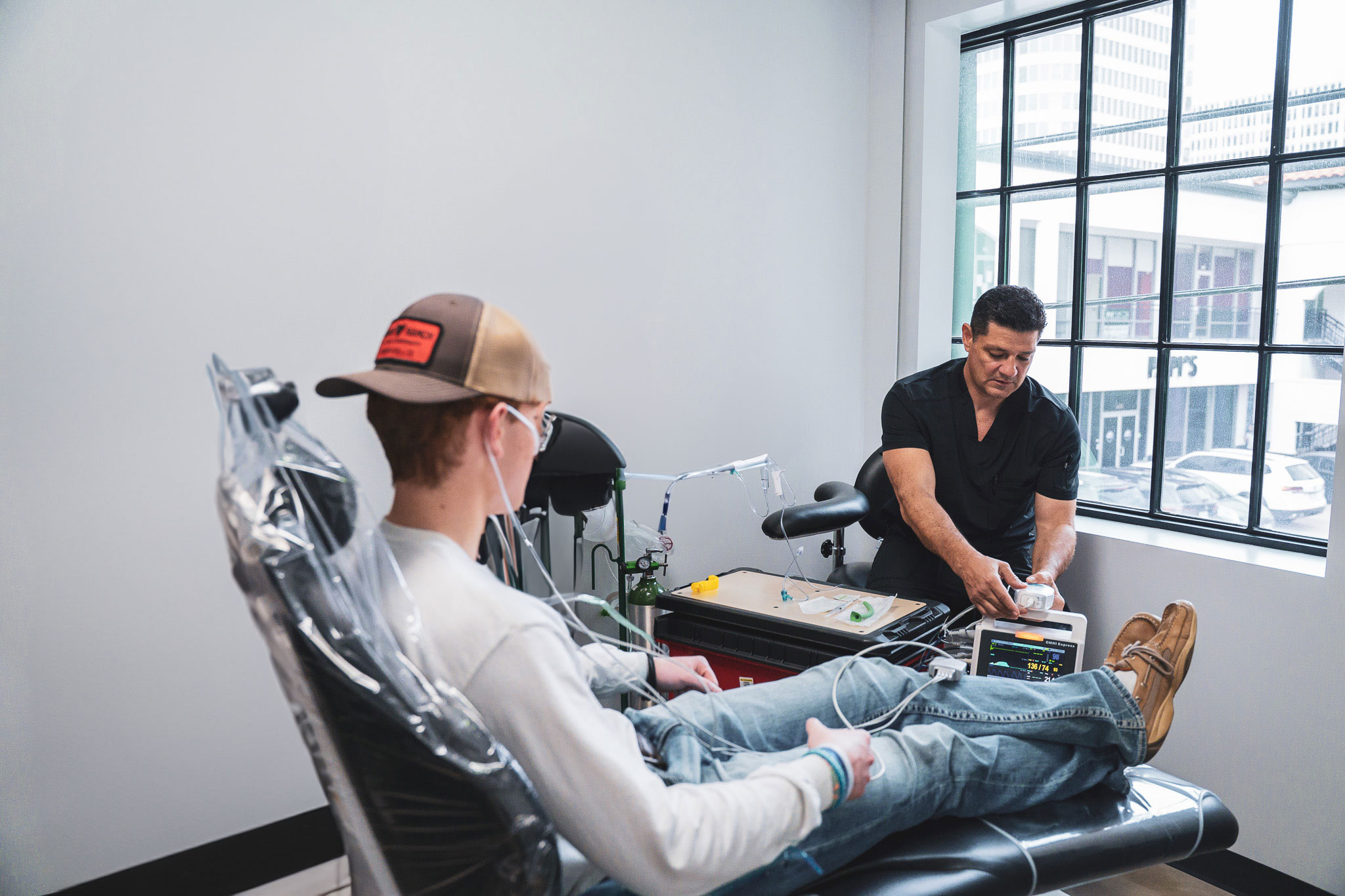As a medical facility, providing safe and effective sedation to your patients is of utmost importance. Intravenous (IV) sedation is a popular method of achieving a desired level of sedation for patients undergoing medical or dental procedures. At Level Up Anesthesia, our team of experienced anesthesia providers, physicians, and highly-qualified nurse anesthetists (CRNAs) are equipped with the latest technology and advanced anesthesia techniques to provide safe and effective monitored anesthesia care for medical and dental offices.


As a medical facility, providing safe and effective sedation to your patients is of utmost importance. Intravenous (IV) sedation is a popular method of achieving a desired level of sedation for patients undergoing medical or dental procedures. At Level Up Anesthesia, our team of experienced anesthesia providers, physicians, and highly-qualified nurse anesthetists (CRNAs) are equipped with the latest technology and advanced anesthesia techniques to provide safe and effective monitored anesthesia care for medical and dental offices.
IV sedation is a method of administering medication directly into the bloodstream to achieve a desired level of sedation, such as light sedation or general anesthesia. Intravenous sedation is used in medical and dental procedures to provide relaxation and pain relief while the patient remains conscious and able to respond to commands. The level of sedation achieved with IV sedation can range from light sedation to regional anesthesia and deeper general anesthesia.

Light sedation, also known as minimal sedation, is the lowest level of sedation. At this level, the patient remains conscious and alert but relaxed. The patient may experience decreased anxiety and discomfort during the procedure. Light sedation is achieved by administering small doses of medication through the IV line. The patient may experience mild side effects, such as a dry mouth, lightheadedness, and decreased coordination.

Light sedation, also known as minimal sedation, is the lowest level of sedation. At this level, the patient remains conscious and alert but relaxed. The patient may experience decreased anxiety and discomfort during the procedure. Light sedation is achieved by administering small doses of medication through the IV line. The patient may experience mild side effects, such as a dry mouth, lightheadedness, and decreased coordination.
Moderate sedation, also known as conscious sedation or procedural sedation, is the most commonly used level of sedation in medical and dental procedures. At this level, the patient is sedated but remains conscious and able to respond to commands. The patient may experience deeper relaxation and pain relief than light sedation. The patient’s vital signs are monitored closely during the procedure. The patient may experience drowsiness, nausea, vomiting, and decreased coordination.


Moderate sedation, also known as conscious sedation or procedural sedation, is the most commonly used level of sedation in medical and dental procedures. At this level, the patient is sedated but remains conscious and able to respond to commands. The patient may experience deeper relaxation and pain relief than light sedation. The patient’s vital signs are monitored closely during the procedure. The patient may experience drowsiness, nausea, vomiting, and decreased coordination.

Deep sedation, also known as deep conscious sedation, is a higher level of sedation than moderate sedation. At this level, the patient is sedated deeper and may be less responsive to commands. The patient is still breathing independently, but their breathing may be slower or shallower. The patient’s vital signs are monitored closely during the procedure. This is achieved by administering a higher dose of medication through the IV line.

Deep sedation, also known as deep conscious sedation, is a higher level of sedation than moderate sedation. At this level, the patient is sedated deeper and may be less responsive to commands. The patient is still breathing independently, but their breathing may be slower or shallower. The patient’s vital signs are monitored closely during the procedure. This is achieved by administering a higher dose of medication through the IV line.
We specialize in providing top-quality anesthesia and IV solutions to medical offices, allowing you to focus on providing excellent patient care. Our team of experienced professionals is committed to ensuring that your practice runs smoothly, efficiently, and without any delays or hiccups. Call us today!
General anesthesia, also known as twilight sedation, is the highest level of sedation used for more invasive medical procedures. At the level of general anesthesia, the patient is completely unconscious and unable to respond to commands. The patient’s breathing is supported by a breathing machine, and their vital signs are closely monitored throughout the procedure. General anesthesia is achieved by administering a higher dose of medication through the IV line. The patient may experience nausea, vomiting, and decreased breathing rate after general anesthesia.


General anesthesia, also known as twilight sedation, is the highest level of sedation used for more invasive medical procedures. At the level of general anesthesia, the patient is completely unconscious and unable to respond to commands. The patient’s breathing is supported by a breathing machine, and their vital signs are closely monitored throughout the procedure. General anesthesia is achieved by administering a higher dose of medication through the IV line. The patient may experience nausea, vomiting, and decreased breathing rate after general anesthesia.
IV sedation offers several benefits over other sedation methods, such as oral or inhaled sedation. The medication is administered directly into the bloodstream, allowing for a more rapid onset of sedation. The level of sedation, such as moderate or deep sedation or general anesthesia, can be adjusted quickly and easily during the procedure to ensure the patient remains comfortable and pain-free. IV sedation is also highly effective in controlling anxiety and minimizing discomfort, allowing patients to undergo medical or dental procedures easily. A trained anesthesia provider must be present during the procedure to monitor the patient’s vital signs and ensure their safety. At Level Up Anesthesia, we take all necessary precautions to minimize the risks associated with IV sedation and ensure safety.
As with any medical procedure, IV sedation carries some risks. It is important to inform the patient of the potential risks and side effects before administering sedation. The risks associated with IV sedation include:
Respiratory depression:
In rare cases, the medication used for sedation can cause the patient’s breathing to slow down or become shallow. This can be dangerous, and the patient may require additional oxygen or assistance with breathing.
Allergic reactions:
Some patients may be allergic to the medication used for sedation, which can lead to a severe reaction. It is important to screen patients for allergies before administering sedation.
Nausea and vomiting:
The medication used for sedation can cause nausea and vomiting, which can be uncomfortable for the patient.
Cardiovascular complications:
In rare cases, the medication used for sedation can cause changes in the patient’s blood pressure or heart rate, which can be dangerous.

IV sedation is appropriate for a wide range of medical and dental procedures. It is commonly used for colonoscopies, endoscopies, dental procedures, and minor surgical procedures. IV sedation dentistry is particularly useful for patients who are anxious or fearful of the procedure, as it can help to minimize discomfort and anxiety. IV sedation can also be accompanied with local anesthesia, but general anesthesia doesn’t require additional anesthetics. General anesthesia puts the patient to sleep, so it’s only reserved for an extremely complex and difficult surgical procedure.
IV sedation is not appropriate for all patients. Patients who have a history of allergies, sleep apnea, or other medical conditions may not be suitable. It is important to evaluate each patient’s medical history before determining the most appropriate level of sedation, be it general anesthesia or light sedation for dental treatment.

IV sedation is appropriate for a wide range of medical and dental procedures. It is commonly used for colonoscopies, endoscopies, dental procedures, and minor surgical procedures. IV sedation dentistry is particularly useful for patients who are anxious or fearful of the procedure, as it can help to minimize discomfort and anxiety. IV sedation can also be accompanied with local anesthesia, but general anesthesia doesn’t require additional anesthetics. General anesthesia puts the patient to sleep, so it’s only reserved for an extremely complex and difficult surgical procedure.
IV sedation is not appropriate for all patients. Patients who have a history of allergies, sleep apnea, or other medical conditions may not be suitable. It is important to evaluate each patient’s medical history before determining the most appropriate level of sedation, be it general anesthesia or light sedation for dental treatment.
IV sedation is a safe and effective method of achieving the desired level of sedation in medical and dental procedures. The level of sedation can be adjusted to meet each patient’s individual needs, and the medication is administered directly into the bloodstream, allowing for a rapid onset of sedation. IV sedation is appropriate for a wide range of medical and dental procedures and can help to minimize discomfort and anxiety in anxious patients.
At Level Up Anesthesia, we prioritize patient care and safety in our anesthesia solutions. Our experienced anesthesia team, physicians, and highly qualified CRNAs are equipped with the latest technology and advanced anesthesia techniques to provide safe and effective office-based anesthesia solutions for medical and dental offices. We provide cost-effective solutions, exceptional customer service, and flexible scheduling to meet the individual needs of our clients.
Contact us today to learn more about our services and how we can help you provide safe and effective sedation to your patients.
